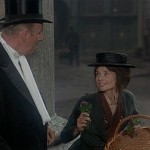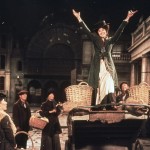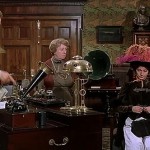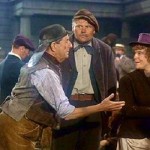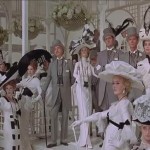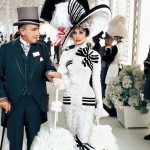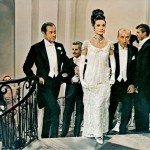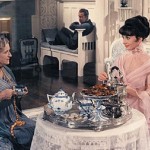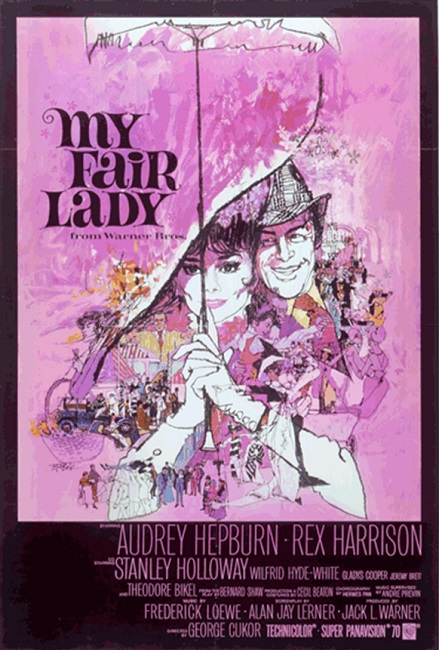
My Fair Lady – 1964
My Fair Lady succeeded where Gigi failed. I’m sorry to say it, but it was, in so many ways, a better film. The plot, the acting, the music, the choreography: all better. Here’s why.
First of all, let’s look at the plot. It is common knowledge among those who love musicals (like me) that My Fair Lady was based on a play called Pygmalion by George Bernard Shaw, which in itself was based on an ancient Greek myth known by the same name. Pygmalion was a sculptor who fell in love with his sculpture. Shaw turned the myth into a play in which a phonetics professor named Henry Higgins transforms (or sculpts) a common flower girl named Eliza Doolittle into a lady who could pass herself off as a duchess by teaching her how to speak and behave in a more genteel manner. The story is quite different than its Greek origins, but one aspect remains true. Though the professor is supremely arrogant and misogynistic, and a confirmed old bachelor by choice, he ends up falling in love with Eliza, just as Pygmalion did with his sculpture.
That, of course is the short version. It is much more complex than that, which brings me to the acting. The acting was first-rate. Rex Harrison plays the part of Professor Henry Higgins. His character could so easily be very one-dimensional, but Harrison does a great job of bringing out a personality that goes beyond the jerk that so often mistreats the poor flower girl. True, he is that person, but on more than one occasion, he shows a softer side that makes him strangely endearing.
Audrey Hepburn is played Eliza Doolittle, and she was absolutely superb. She is beautiful, and wonderful to watch. She easily passed herself off as both the poor and uneducated flower girl, and the regal and self-assured lady of high society. She was neither a dancer, nor a singer (we’ll get to that in a minute…) but she was a fantastic actress, handling the comedy and the drama with equal skill. However, I was actually surprised to learn that she wasn’t even nominated for Best Actress.
Other notable members of the cast were Stanley Holloway as Eliza’s father, Alfred Doolittle, a common dustman, Gladys Cooper as Henry’s mother, Mrs. Higgins, Mona Washbourne as Mrs. Pierce, Higgin’s housekeeper, and in a fairly minor role, Theodore Bikel as Zoltan Karpathy, Higgins’ sleazy ex-student. Bikel didn’t have much screen time, but he was fun to watch. And lest I forget, Jeremy Brett as Freddy Eynsford-Hill, a young fop who falls hopelessly in love with Eliza.
That’s important because here’s the catch about the plot. There has been some controversy regarding the ending. In the film, Eliza finally finds her independence, realizes that Henry really does care for her, and returns to him. In Shaw’s play, she finds her independence, leaves Henry and marries Freddy. The analogy to the Greek myth is that the sculpture finally comes to life and is able to love Pygmalion or not as she chooses. Shaw insisted that she does not. Lerner and Lowe, who wrote the musical, gave it a more audience friendly ending.
That brings us to the music. Lerner and Lowe wrote a lot of great songs for the show, songs that have become standards of musical theatre repertoire. Wouldn’t It Be Loverly, With A Little Bit of Luck, I Could Have Danced All Night, Just You Wait, The Rain In Spain, On the Street Where You Live, Show Me, Get Me to the Church On Time, and Without You. These were all great songs. Unfortunately, Audrey Hepburn was not known for her singing. But once again, thank goodness for Marni Nixon, who, you may remember, dubbed much of the singing in West Side Story. She did the same for Hepburn and sounded fantastic.
Interesting note: Hepburn’s own voice was left in for most of the song Just You Wait, as the song was heavily character driven, though on the softer bridge of the song, Nixon once again took over.
The score is gorgeous and romantic. Add to this the incredibly beautiful costumes, for which Cecil Beaton won his own Oscar, and the lavish sets, and you have the makings of a very impressive production. Just the fashions they designed for Hepburn alone were absolutely lovely. Beaton must have had a field day during the Ascot Race sequence. The costumes were all just black and white, but they were each wonderfully unique and utterly fabulous.
Lastly there was the choreography. It all seemed natural. The movements of the actors all seemed organic, which is not easy to do when you are singing. Nothing was awkward or forced.
Being a fan of musicals, I have seen this film many times. There are several scenes which always stand out to me as either fun to watch or heart-wrenching. Sometimes both! For example, the scene in which Mrs. Pierce first takes Eliza to her room to give her a bath. Poor and ignorant Eliza, who has never had a bath in a proper tub, becomes horrified. She has gotten herself in a little over her head. Mrs. Pierce and her maids are made to forcibly remove Eliza’s clothes and have them burned. My heart weeps for Eliza in this scene. She is in a strange house, where strangers are trying to strip her naked, steal her clothing, and dunk her completely in water. She is absolutely frightened and panics. She begins screaming in bloody abject terror as the hot steam of the bath fills the room. For some reason, that scene always makes me feel for her.
Another scene is the hilarious scene at the Ascot Races in which Eliza’s carefully practiced mask of genteel civility slips in a most cataclysmic way. As the horses are running past, she screams at her horse “Com on Dover! Move yer bloomin’ Ass!!!” The lords and ladies are driven to fainting!
There is the magical scene at the Embassy Ball where Eliza has fully become the regal lady she has been training to be. She is so absolutely gorgeous in this scene that the Prince of Transylvania singles her out and asks her to dance. Hepburn is simply wonderful.
Lerner and Lowe’s stage show was a great one to begin with and director, George Cukor did a top-notch job bringing it to the silver screen. I found it interesting that the point of the movie, the moral center, if you will, came down to one statement in the end. Eliza is talking to Mrs. Higgins while Henry is sulking in the background. She profoundly says, “You see Mrs. Higgins, apart from the things one can pick up, the difference between a lady and a flower girl is not how she behaves, but how she is treated.” Truer words were never spoken.
Interesting note: OK, after all my gushing about how wonderful this movie was, here, I think, is one minor little error. At the end of the film, Professor Higgins has arrived at home, and is ready to unlock his front door. He inserts his key, takes it out, and opens the door. I have to chuckle. He never turned the key to unlock the door. Oops!
